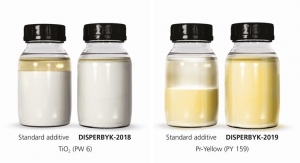Kerry Pianoforte, Editor 06.27.18
The June issue of Coatings World featured an interview with a number of key suppliers of performance-enhancing additives. These include: Mark Piggott, senior account manager, Arkema Coating Resins; Katie Fagan, marketing manager, Formulation Additives, BASF and Shiona Stewart, industry marketing manager-Transportation, Industrial, Furniture, and Floor Coatings, BASF; Brendan Cullinan, Brenntag North America ACES technology director; Dr. Guillaume Jaunky, head of TG Surface, BYK and Mark Heekeren, head of TS Surface, BYK; Dave Grabacki, president, keim additec surface USA; Scott A. Brown, global technical manager, Materials Performance and Protection, Lonza; John McAllister, global director of sales, Micro Powders Inc.; Joon Choo, vice president, Shamrock Technologies; Frank Cangelosi, Ph.D., vice president, marketing, Troy; and Scott VanRemortel, technical sales manager, Unimin.
Part 2 of that interview discusses trends in the additives market:
Arkema: Whether the application is water-based, solvent-based or high-solids, product designers are developing additives that allow easier incorporation, more efficient coating application, and consistent field performance. The legislation is pushing towards greener technologies with lower VOC contents. This trend comes along with specific challenges related to rheology, particularly for industrial coatings. Those paints present logically higher viscosity but also different drying profiles and are more difficult to spray. To control rheology is key to ensure coatings stability, ease of application and to ensure thickness control. It is why our additive department developed rheology modifier suitable for higher solid content (very high solid and solvent free. Crayvallac rheology modifiers can help to face up these challenges.
However, they need an activation step to provide the rheological network that will bring the rheological benefits. This activation is performed by using heat and shear and is dependent on solvent type and content. Therefore we focused our efforts to develop additives that will be easier to activate in fewer solvents for those specific new coating systems.
BASF: Reactive technologies are growing in interest, because the reactivity ensures that additives stay in the coating while offering synergistic effects, for incredible performance enhancement. For example, our new reactive dispersant crosslinks into the main resin matrix creating an additional binding force for the coating components. This leads to enhanced hardness, film durability, and protection for substrates while still delivering beautiful pigment dispersion…this is atypical for dispersants, where hardness and dispersing efficiency are often at odds with one another.
Another BASF technology that offers unique value in the coatings market is the Efka IO additive products. These additives can provide conductivity to coatings for protective (anti-stat and dissipative scenarios) and application (conductivity control for electrostatic spray applications, etc.) value. Efka IO conductive additives are clear in nature unlike conventional conductive carbon pigments, and therefore allow more esthetic choices than black and shades of gray. And finally, they have demonstrated synergistic effects with conductive pigments, which allows one to achieve desired conductivity with less conductive pigment in the formulation, enabling cost savings.
Brenntag: Multifunctional Additives. When an additive supplements a coating, unforeseen problems may arise. Additive manufacturers are developing multifunctional additives addressing several functions, thereby minimizing complication. Reducing the number of variables (components) that enhance (and potentially weaken) a system will improve performance. New biocide and preservative technology are exciting – safer, effective, multifunctional.
BYK: One breakthrough in macromonomer technology is that even silicone-containing additives are able to increase the surface energy, even if this sounds like a discrepancy.
keim additec: Today's paint market is pushing for low- /non-emission paints.
Solvents are no longer formulated. By that reason, the time frame to rework painted areas is shortened and the open time needs to be extended.
SILCONA developed an open time extender without the negative side effects of decreased stain resistance or longterm stickiness.
Lonza: Coatings which provide an antimicrobial surface after application are an active area of new product development.
Micro Powders: Micro Powders leads the composite wax segment with unique micronized melt blends like our Polyfluo series; melt composites of polyethylene and polytetrafluoroethylene. We’ve advanced this technology by introducing inorganic materials to the melted composite such as nano alumina and ultrafine ceramic. These modifiers further enhance the wax’s ability to offer superior abrasion and scratch resistance in performance finishes.
Shamrock Technologies: Formulators have asked for easier-to-use and multifunctional products, and in many cases, pre-dispersed formulations which are stable and have a longer shelf life. Much of the new development work has been directed at fulfilling these requests.
Troy: ‘Green’ technology continues to drive the development of performance additives. Zero or low VOC, sustainability, and renewable ingredients are all features being incorporated into the latest performance additives, such as those recently introduced by Troy. In addition, improved performance and low cost-in-use continue to be critical in today’s competitive market.
Unimin: Super Stain Resistance and Washable interior deco coatings in North America (NAM) and materials that can contribute to this.
Part 2 of that interview discusses trends in the additives market:
Arkema: Whether the application is water-based, solvent-based or high-solids, product designers are developing additives that allow easier incorporation, more efficient coating application, and consistent field performance. The legislation is pushing towards greener technologies with lower VOC contents. This trend comes along with specific challenges related to rheology, particularly for industrial coatings. Those paints present logically higher viscosity but also different drying profiles and are more difficult to spray. To control rheology is key to ensure coatings stability, ease of application and to ensure thickness control. It is why our additive department developed rheology modifier suitable for higher solid content (very high solid and solvent free. Crayvallac rheology modifiers can help to face up these challenges.
However, they need an activation step to provide the rheological network that will bring the rheological benefits. This activation is performed by using heat and shear and is dependent on solvent type and content. Therefore we focused our efforts to develop additives that will be easier to activate in fewer solvents for those specific new coating systems.
BASF: Reactive technologies are growing in interest, because the reactivity ensures that additives stay in the coating while offering synergistic effects, for incredible performance enhancement. For example, our new reactive dispersant crosslinks into the main resin matrix creating an additional binding force for the coating components. This leads to enhanced hardness, film durability, and protection for substrates while still delivering beautiful pigment dispersion…this is atypical for dispersants, where hardness and dispersing efficiency are often at odds with one another.
Another BASF technology that offers unique value in the coatings market is the Efka IO additive products. These additives can provide conductivity to coatings for protective (anti-stat and dissipative scenarios) and application (conductivity control for electrostatic spray applications, etc.) value. Efka IO conductive additives are clear in nature unlike conventional conductive carbon pigments, and therefore allow more esthetic choices than black and shades of gray. And finally, they have demonstrated synergistic effects with conductive pigments, which allows one to achieve desired conductivity with less conductive pigment in the formulation, enabling cost savings.
Brenntag: Multifunctional Additives. When an additive supplements a coating, unforeseen problems may arise. Additive manufacturers are developing multifunctional additives addressing several functions, thereby minimizing complication. Reducing the number of variables (components) that enhance (and potentially weaken) a system will improve performance. New biocide and preservative technology are exciting – safer, effective, multifunctional.
BYK: One breakthrough in macromonomer technology is that even silicone-containing additives are able to increase the surface energy, even if this sounds like a discrepancy.
keim additec: Today's paint market is pushing for low- /non-emission paints.
Solvents are no longer formulated. By that reason, the time frame to rework painted areas is shortened and the open time needs to be extended.
SILCONA developed an open time extender without the negative side effects of decreased stain resistance or longterm stickiness.
Lonza: Coatings which provide an antimicrobial surface after application are an active area of new product development.
Micro Powders: Micro Powders leads the composite wax segment with unique micronized melt blends like our Polyfluo series; melt composites of polyethylene and polytetrafluoroethylene. We’ve advanced this technology by introducing inorganic materials to the melted composite such as nano alumina and ultrafine ceramic. These modifiers further enhance the wax’s ability to offer superior abrasion and scratch resistance in performance finishes.
Shamrock Technologies: Formulators have asked for easier-to-use and multifunctional products, and in many cases, pre-dispersed formulations which are stable and have a longer shelf life. Much of the new development work has been directed at fulfilling these requests.
Troy: ‘Green’ technology continues to drive the development of performance additives. Zero or low VOC, sustainability, and renewable ingredients are all features being incorporated into the latest performance additives, such as those recently introduced by Troy. In addition, improved performance and low cost-in-use continue to be critical in today’s competitive market.
Unimin: Super Stain Resistance and Washable interior deco coatings in North America (NAM) and materials that can contribute to this.

















